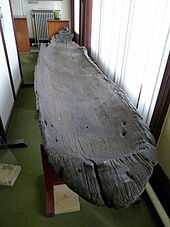Martin Mere
| Martin Mere | |
|---|---|
 Flamingos | |
| Location | Lancashire |
| Coordinates | 53°37′21″N 2°52′7″W / 53.62250°N 2.86861°WCoordinates: 53°37′21″N 2°52′7″W / 53.62250°N 2.86861°W |
| Type | mere |
| Basin countries |
United Kingdom |
| Designated: | 28 November 1985 |
Martin Mere is a mere near Burscough, in Lancashire, England, on the West Lancashire Coastal Plain. The mere is a vast marsh, around grid reference SD 41 15 that, until it was drained, was the largest body of fresh water in England.[1]
History
Martin Mere was formed at the end of the last Ice Age, when water filled a depression in the glacial drift. Since then its size has varied as water levels have risen and fallen. The original giant lake can be seen on Christopher Saxton's map from 1579 and stretched from Rufford in the east, to Churchtown (then known as Meols) in the west. To the north of the lake were the villages of Mere Brow and Holmeswood, the site of Holmeswood Hall, built by the Heskeths as a hunting lodge. South of the lake was the Scarisbrick Hall estate, Martin Hall and Tarlefarwood, now known as Tarlscough.[2]
Active management of the mere began in 1692 when Thomas Fleetwood of Bank Hall cut a channel in an attempt to drain it.[3] Further attempts to drain it were made in the 1780s, but effective drainage was only achieved in the mid-19th century with the introduction of steam pumping. Farms and market gardens were established on the rich soils of the reclaimed land. Between 1974 and 1982 sand from the former lake bed was quarried for use in glass-making at Mere Sands Wood which is now a nature reserve.

An ancient canoe has been excavated from Martin Mere and is the oldest item on display in the Botanic Gardens Museum.
Present
The mere is now the site of Martin Mere Wetland Centre, a wetland nature reserve managed by the Wildfowl and Wetlands Trust.
Culture
Martin Mere once stretched to Park Hall near Chorley, home of Camelot Theme Park which was named from the legend. Sir Lancelot's parents, King Ban of Benwick and his queen Elaine, escaped to Lancashire from France. Elaine went to help her husband who had fallen and put Lancelot down on the shore of the lake, from where he was abducted by a nymph, Vivian, who vanished into the waters of the lake with him. When Lancelot went to Arthur's court he was knighted as 'Sir Lancelot of the Lake'. Martin Mere has been known as the 'Lost Lake of Sir Lancelot' following the myth.[4]
See also
References
- ↑ Martin Mere: Lancashire's Lost Lake, W. G. Hale and Audrey Coney. Liverpool: Liverpool University Press, 2005.
- ↑ "Christopher Saxton's 1579 map" http://freepages.genealogy.rootsweb.ancestry.com/~genmaps/genfiles/COU_files/ENG/LAN/saxton_lancs_1579.htm |accessdate=24-07-2010
- ↑ http://www.heskethbank.com/history/bulpit/bulpittltn.html
- ↑ Ashworth. E, (2007) "Tales of Old Lancashire - The Lost Lake of Sir Lancelot", Pages 39-41.
| Wikimedia Commons has media related to Martin Mere. |